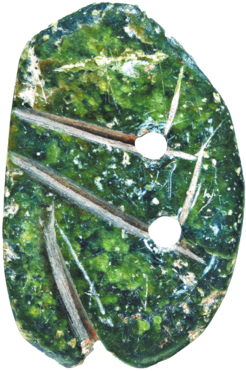Two great civilizations share a cup of knowledge

One of the exhibits that start the exhibition The Glory of the Aegean Sea at the Nanjing Museum is a tiny stone amulet with a surface area of no more than 9 square centimeters and a thickness of around 0.6 cm. Its oval contour, together with a few incised lines across its surface, reminds a viewer of a curled-up human figure or a fetus in the womb.
And that offers an apt metaphor for ancient Greek civilization, which the exhibition is hoping to shed light on through more than 270 pieces of exhibits from 14 museums and cultural organizations in Greece. The creativity and splendor spawned by that civilization means it has been viewed by many as lying at the origin of Western civilization, having exerted foundational influence on the latter in areas ranging from philosophy and science to art and literature.
It's a starting point that people in the West look back on from time to time: the Renaissance that ended the millennium-long Dark Ages was emphatically declared a revival of interest in the ideas, art and literature of ancient Greek — and by extension Roman — civilization.
For those familiar with Chinese history, that gigantic, society-wide effort, which involved among many other things the study of ancient Greek texts, might bring to mind one man: Confucius (551-479 BC). Living in the lively and chaotic time of China's Spring and Autumn Period (770-476 BC), the philosopher, long enshrined by Chinese history, advocated for his contemporaries to look back to the early Western Zhou Dynasty (c. 11th century-771 BC) as a model for moral governance and social harmony.
"It was still far too early for the two civilizations to intersect, let alone interact, but that doesn't mean parallels couldn't be found," says Guan Lin, curator of the Nanjing Museum exhibition, which is being held at the same time of another exhibition at the Shanghai Museum focusing on ancient Egyptian civilization and another one, at the Suzhou Museum, which is introducing its audience to the equally resplendent but lesser-known culture of ancient Assyria.
"Collectively, they have offered us a worldview and a reference point from where we could examine our own cultural traditions," says Ma Minghe, who has been to all three shows.
Back at the Nanjing Museum exhibition, a frying pan-shaped clay vessel dating between 2800 BC and 2300 BC is decorated with the image of a multi-oared longboat. The boat is surrounded by sea waves, as suggested by the repeated spiral pattern.
"Ancient Greek civilization is an ocean civilization in the true sense of the word," says Guan.
The item, a piece of tin-glazed pottery dating to the 16th century BC, is on loan from the National Archaeological Museum in Athens, which also has among its collection a seashell-shaped ceremonial drinking vessel known as a rhyton. More than 2,200 years later, similar-shaped vessels, often made of precious metals or stones, would travel the ancient Silk Road to the capital of China during the Tang Dynasty (618-907), where they were known as the laitong cup, laitong being a homophone to rhyton.
A superb example was unearthed in 1970 from what's believed to be a Tang Dynasty storage of precious items in a small village located in the southern suburbs of Xi'an city, the one-time capital of Tang. Known today as Hejiacun Village Hoard, this treasure trove is widely viewed by archaeologists as offering compelling evidence to the level of material exchange going on across the ancient trade route.
Buried with many pieces of Sassanianstyle gold and silver wares was this rhyton wine vessel carved out of beautifully striated agate into a horned bull head whose streamlined, upward-bending curve recalls the ascending spiral of a magnificent seashell. The bull's nose, minted in gold, serves as the vessel's stopper, with glitter accentuated by the muted colors of the agate.
Between this agate rhyton, believed to have been brought to Tang China by Sogdian merchants who dominated the ancient Silk Road between the 4th and 7th centuries, and the seashell-shaped one from ancient Greece, there were numerous others produced over large areas of ancient Eurasia, particularly from Persia to the Balkans. Very often, they took the shape of an animal's head or a bullhorn.
In fact, the word rhyton comes from the Greek word rhein, which means "to flow through", thus the two openings on each end of the vessel. Judging by all evidence, it seems that the same words could also be said of ancient Greek civilization itself, which had either trickled or flooded its way across continents and ages to enable a meeting between an ocean civilization and its many land counterparts.
The Nanjing Museum exhibition concluded with a small chapter dedicated to Alexander the Great (356-323 BC), the king of Macedonia — Macedonia being a Greek city-state — and an invincible warrior who, remarkably, harbored a tolerant side and believed in a multicultural society. By sacrificing to the gods of his conquered land and honoring their traditions, Alexander greatly expanded the influence of ancient Greek civilization in a way that also allowed for "a creative synthesis of cultures", to use the words of Angeliki Kottaridi, a highly regarded Greek archaeologist.
In 327 BC, seven years after Alexander invaded the Achaemenid Persian Empire, Alexander married Roxana, a Sogdian princess, despite opposition from those close to him who would have preferred a Macedonian or other Greek to become queen. The ancient Sogdians were an Eastern Iranian people who inhabited the region of Sogdiana in modern-day Central Asia, from where they later embarked on their Silk Road journeys.
However, Alexander, whose ultimate goal was to reach the "ends of the world and the Great Outer Sea", didn't stop there. He invaded India the very next year but eventually turned back at the Beas River in Punjab at the demand of his homesick troops. He died in 323 BC in Babylon, not knowing that there was a whole wide world lying beyond his "ends of the world".
That death, which some equated with the end of ancient Greek civilization, heralded in another historical period known as the Hellenistic Period (323-31 BC). Marked by Rome's rise to prominence, this period saw the continued spread of Greek cultural influence throughout the eastern Mediterranean and the Near East. Some scholars even suggested that this period may have witnessed the earliest interactions between the civilizations of ancient Greece and China, as Alexander's expansion into Central Asia brought the influence of Greek culture closer to the outer frontiers of China's powerful Western Han Dynasty (206 BC-AD 24).
Julius Caesar (100-44 BC), the legendary Roman general, was believed to have once turned up at a theater draped in resplendent Chinese silk, causing an outcry from the senate whose members had arguably sought to ban silk importation from China in an effort to prevent the outflow of gold. That was about eight decades after the initial opening of the ancient Silk Road, by the legendary Chinese emissary-explorer Zhang Qian between 139 BC and 126 BC.
That story was never substantiated, but a popular Latin saying of the time went: Seres, a fortunatissimis sinibus. Seres refers to the people of Serica, an ancient term often associated with China or other silk-producing Asian regions. The phrase effectively translates into "The Seres, from the most fortunate and prosperous shores".

































